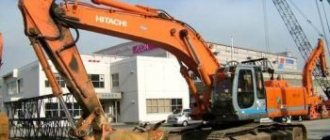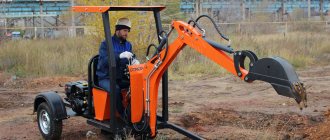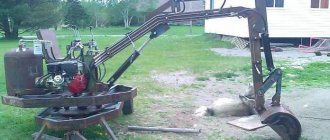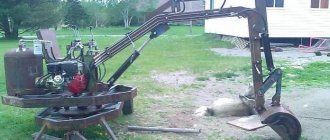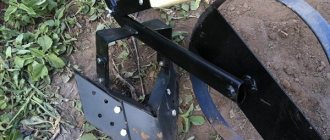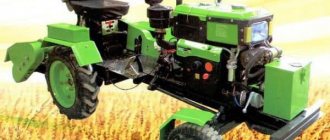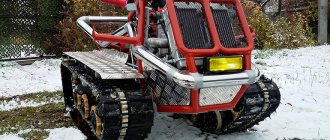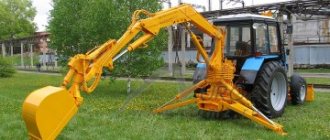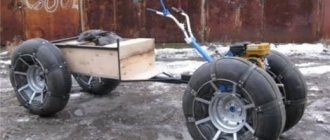There are cases when it becomes necessary to carry out fairly targeted excavation work. This means that their implementation must be extremely careful and carried out using appropriate technology.
For example, you needed to dig a small trench at your summer cottage for an artificial pond or for cable wiring. The use of large equipment (see Hyundai excavators), in this case, is inappropriate for a number of reasons.
This is due to the excessive cost and insufficient maneuverability of such equipment in small areas of space. Of course, you can use a hand-held digging tool, but this will be a very labor-intensive and time-consuming process. You can use mini excavators. Read about models from Russian manufacturers here.
Therefore, the best way out of this situation would be to use special equipment - a trailed mini-excavator.
Design specifics
As the name itself implies, such mini-excavators are not suitable for independent movement around the territory. To move from one construction site to another, most often, cars or tractors (see New Holland tractor) are used, acting as a kind of tugboat.
Mini excavator with supports
In addition to the bucket, the design of the mini-excavator includes a wheelbase that allows you to easily move the object around the territory. Depending on the configuration, trailed mini-excavators can have a two- or four-wheel system, as well as a support that allows the unit to be coupled to the ground.
Naturally, the more working supports are installed on the equipment, the more stable it is located on the territory, having a wider range of action.
“Deep” content in compact dimensions
Many builders who have operated Komatsu PW 118 MR-8 excavators believe that this machine, like no other, is effective when performing work in cramped conditions and when participating in road construction technologies, when laying sewers and when demolishing various objects.
The PW 118 MR-8 model, with dimensions of 7.5 x 2.5 x 4 m and a weight of 12.3 tons, is the result of joint efforts by Japanese and European engineers. Modern technologies developed in Japan were combined in the design of the PW 118 MR-8 with the requirements of the European market. The excavators are manufactured by Komatsu Utility Europe at a plant in Este, Italy.
The small turning radius and compact linear dimensions provide the machine with a wide range of capabilities. Significant breaking force (44.5/73.5 kN) and a boom with a horizontal reach of up to 7.65 m allow soil to be removed from a depth of up to 4.33 m.
Fuel savings are ensured by the automatic speed control system used, as well as the auto-braking system, which reduces the engine speed to a minimum as soon as the control levers are in the neutral position. The use of Ecot3 technology in the engine makes it possible to ensure a very low level of NOx emissions in the exhaust gases.
Information about the efficiency of the machine is displayed via a special eco-sensor on the monitor in the cabin. In addition, there is an EMM controller that analyzes all key parameters of the machine, such as oil pressure, coolant temperature, battery charging status, etc. If there is an abnormality, a warning appears on the monitor. The operator is also warned in advance about the need for scheduled oil or filter changes on the machine.
The operator's work is simplified by the ability to select one of five programmed operating modes - from maximum fuel economy mode to maximum power mode. The machine's performance is enhanced by the use of the Common Rail system, which allows for the most efficient use of the energy of combustion fuel and reduces carbon dioxide emissions through electronic control of fuel injection. And the use of the CLASS hydraulic system makes it possible to increase the speed of movement of the working bodies, as well as achieve jewelry-precise execution of the operator’s commands.
The car has three steering modes. The operator can control either only the front wheels, or all the wheels of the excavator, or use the “crab” drive. The ability to select a steering pattern provides excellent maneuverability and flexibility in machine control. Moreover, the modes are activated by simply pressing a switch on the panel in the cockpit. The green light indicates which control mode is in effect.
The spacious excavator cabin is equipped with sliding doors. This design solution is especially useful in situations where the work area is very limited. For ventilation, a conveniently opening hatch is installed on the roof. To create additional comfort at work, it is possible to adjust the position of the control levers and the chair, and the automatic air conditioner operating in the “winter/summer” mode provides optimal temperature working conditions all year round. Due to the large glass area, the operator can observe everything that is happening from all sides of the cabin.
Application area
The use of this technique is advisable in cases where the surface being processed has fairly limited dimensions, which naturally affects the requirements for the technique used.
Often, the use of conventional excavators in such areas is unprofitable and impossible, due to the large dimensions of such equipment.
It is clear that the power of a trailed mini-excavator will be much less than that of a standard excavator (for example, EO 2621), but it is quite enough for small earthworks.
For digging a trench
The main types of work performed by a trailed mini-excavator:
- Cleaning the surrounding area from various large-sized debris.
- Digging various trenches and channels intended for laying communication systems.
- Digging channels to drain water.
- Various loading operations (like a JCB backhoe loader).
- Landscape works.
- Various works in the construction industry.
Due to the fact that the cost of such equipment is at a fairly adequate level, its use extends not only to various municipal or agricultural organizations, but also for use by private individuals for their needs.
Description and scope of application
Mini-excavators are divided into tracked and wheeled , they are characterized by simple and ergonomic operation, their small volume and weight allow them to work in hard-to-reach places and, if necessary, quickly replace buckets. Read the article about the difference between tracked and wheeled loaders here.
Wheeled mini excavator
Many models do not require specialized transport for transportation, and they are much easier to operate than a large machine. The use of attachments allows (albeit in slightly smaller volumes) to perform the same types of work as with a conventional excavator.
Tracked vehicles move five times slower than wheeled vehicles , but can be used on soft or wet clay, in completely off-road conditions, in a pit. For small jobs on scattered objects, wheeled options are more suitable.
There are no fundamental differences in the class of mini-excavators; they all consist of three parts: chassis, superstructure and working equipment. Differences in size, price and performance. Compact equipment has proven itself to be used in various types of activities:
- city utilities, road and emergency services;
- gas and water supply organizations;
- in communications and energy;
- green farms;
- emergency services;
- in small construction;
- in archaeology.
Designers are constantly looking for fundamentally new solutions, and in addition to self-propelled equipment trailed mini-excavators , which are suitable in price and mobility for private owners with small but regular volumes of work. There are options for attaching excavator equipment to mini loaders.
Technical characteristics and prices of various models
There are quite a large number of companies specializing in the production of trailed mini-excavators, which somewhat complicates the process of choosing a particular model. All of them have a considerable number of advantages over each other, knowledge of which will help you make the right choice.
TD-1
This brand of mini-excavator is manufactured in the UK. Due to its rather modest dimensions, this equipment can be transported using a regular car or ATV.
You can see more detailed information in the videos below:
Technical characteristics of TD-1:
- type of engine used - diesel or gasoline (depending on the configuration);
- The power of the engine used is 9 or 10 hp. (depending on the configuration);
- fuel consumption - about 1.5 liters per hour;
- boom lift height – 2.4 m;
- digging depth – 2.3 m;
- maximum load capacity – 200 kg;
- total weight – 465 kg;
- productivity – about 2 m3 for 15 minutes;
- unit length – 3.22 m;
- unit width – 1.95 m;
- The width of the bucket used is from 25 to 60 cm.
The price for such equipment varies around 250 thousand rubles, depending on the region of sale. This is several times lower than the prices of conventional excavators. For example, prices for Caterpillar excavators start at 3 million rubles.
Landformer
This equipment is produced at the plant of the same name in Germany. Depending on the configuration, it can run on diesel or gasoline.
Landformer specifications:
- total weight (gross) – 520 or 532 kg;
- fuel consumption - about 3 liters per hour;
- type of engine used - diesel or gasoline (depending on the configuration);
- The power of the engine used is 15 hp. for the petrol version and 10 hp. for diesel;
- digging depth – 2.3 m;
- maximum load capacity – 300 kg;
- productivity – about 6 m3 per hour;
- unit length – 3.22 m;
- unit width – 1.95 m;
- The width of the bucket used is from 22 to 60 cm.
The cost of this model will be calculated based on which engine will be used in the final configuration. For the gasoline version, the price varies around 220 thousand rubles, for the diesel version – about 235 thousand rubles.
TI-EX 13
This model is a domestic product intended for use in the Russian climate and soil conditions. Such equipment has proven itself in a wide variety of industries: gas, electrical, agricultural, construction, etc.
Technical characteristics of TI-EX 13:
- total weight – from 350 to 400 kg;
- engine used - Lifan;
- the power of the motor used is 13 hp;
- digging depth – up to 2 meters;
- fuel consumption - 1.2 liters per hour;
- type of engine used - gasoline;
- unit length – 2.12 m;
- unit width – 1.25 m;
- loading height – 1.7 m.
The price for a trailed mini-excavator TI-EX 13 will be in the range from 200 to 250 thousand rubles.
Scorpion
The Scorpion trailed mini-excavator is produced in Volgograd. Due to its small dimensions, this unit can be transported using a passenger car. The only condition is the presence of a tow bar on the car.
Technical characteristics of Scorpio:
- digging depth – 2.5 m;
- total weight – 650 kg;
- the width of the bucket used is from 16 to 45 cm;
- fuel tank volume – 22.5 l;
- unit width – 2.07 m;
- availability of operator's seat - yes;
- loading height – 2.2 m.
The cost of this unit is about 250 thousand rubles, depending on the region.
Digger-2500
This Russian trailed mini-excavator was made based on Chinese models. Manufacturers have significantly improved the power units and other technical features of the unit.
Digger-2500
Technical characteristics of Digger-2500:
- type of engine used - gasoline;
- the power of the engine used is 9 hp;
- fuel consumption – 1.6 liters per hour;
- digging depth – 2.6 m;
- productivity – about 8 m3 per hour;
- total weight – 534 kg;
- the width of the bucket used is from 30 to 60 cm;
- unit length – 3.22 m;
- unit width – 1.95 m;
- unit height – 2.1 m;
- loading height – 2.5 m.
This line of mini-excavators also includes other models based on the Digger-2500:
- Digger-2500-2G - this model has a gasoline engine with a power of 13 hp. There are two power supports and one wheel axle.
- Digger-2500-4GS – this unit has a diesel engine with a power of 20 hp. The package includes four working axles and two wheel axles.
The new trailed mini-excavator Digger-2500 will cost at least 260 thousand rubles.
HBP-9
This model is produced in Chinese factories, based on Landformer technologies. It is transported to the site of excavation work by a regular vehicle using a tow bar.
Mini-excavator NVR-9
Technical characteristics of HBP-9:
- type of engine used – diesel;
- the power of the engine used is 9 hp;
- fuel consumption – 1.5 liters per hour;
- loading height – 2.4 m;
- digging depth – 2.15 m;
- maximum load capacity – 300 kg;
- bucket width – 30 cm;
- productivity – about 4 m3 per hour;
- total weight – 530 kg;
- unit length – 3.22 m;
- unit width – 1.95 m;
- unit height – 2.1 m.
Many note the fairly good performance indicators of this model at a relatively low cost.
Other features of this unit:
- The fairly simple design of the model allows it to be used without extensive technical knowledge.
- The unit is controlled using four levers, without further complicating the process.
- The package includes an emergency engine shutdown system.
- The unit can move independently along the surface of the earth.
The cost of HBP-9 will start from 240 thousand rubles and above, depending on the region of sale.
Russian-made HBP-13
This model is an improved version of the HBP-9, also produced in China.
Technical characteristics of HBP-13:
- type of engine used - gasoline;
- the power of the engine used is 13 hp;
- fuel consumption – 2 liters per hour;
- loading height – 2.2 m;
- digging depth – 2.3 m;
- maximum load capacity – 400 kg;
- the volume of the bucket used is from 20 to 40 cm;
- productivity – about 8 m3 per hour;
- total weight – 900 kg;
- unit length – 4 m;
- unit width – 1.6 m;
- unit height – 2.3 m.
Mini-excavator NVR-13
This equipment comes with 4 working supports, which allows it to show very high stability on the surface, avoiding overturns and falls. In addition, the HBP-13 has an operator's seat that is height adjustable. The cost of this equipment will vary around 400 thousand rubles.
Selecting the operating mode of the tool - on the operator panel
One of the latest developments by Hitachi engineers, successfully demonstrated at the last 30th Bauma International Exhibition, was the mod excavator. ZX140W-5. The model is characterized by a very wide range of production capabilities. According to experts, for small construction companies such a machine is simply irreplaceable, since it copes well with excavation operations and is ready to carry out a wide variety of technological operations, for which the manufacturer offers a large selection of additional attachments.
Controlling the operation of the equipment is simple - the latest system provides automatic selection of operating modes for 11 main attachments. “Icons” with schematic representations of tools are displayed on the monitor in the cabin, and the operator only needs to press the corresponding button. The current operating pressure programming system reliably protects against the supply of hydraulic fluid under high pressure through the pipeline supplying a particular tool.
The powerful (90.2 kW) Isuzu diesel engine of the latest generation, despite meeting the high EU Stage III environmental requirements, is very productive and economical. The maximum digging depth of the ZX140W-5 is almost 5.3 m, and the breakout force reaches 104 kN. Low fuel consumption is also maintained through the use of an upgraded Hios III hydraulic system in the machine.
When developing the excavator cabin, Hitachi took into account that the machine must work fully on construction sites that are densely filled with other construction equipment and have limited working space. For comfortable and efficient work, the right side of the cab has been redesigned, and the front of the excavator has also received a new design compared to cabs of previous years.
The multifunctional LCD monitor installed to the right of the operator does not reduce the field of view at all. Such monitors are now installed on all Zaxis-5 series machines; a large amount of technical information is displayed on the screen, including the image from the rear view camera, thanks to which the operator sees everything that is happening behind the machine.
Advantages
The insufficient power of such units is the only drawback, which is offset by a number of advantages.
At the same time, the use of trailed mini-excavators is quite specific, for performing a certain type of work that does not place high demands on the power indicators of a particular unit. For all other work, large excavators are used, such as Volvo backhoe loaders.
So this drawback seems even more insignificant.
The main advantages of such mini-excavators are:
- Quite high reliability.
- In case of various breakdowns, repairs do not require increased costs and qualifications.
- Easy to maintain.
- There is a fairly large list of earthworks that such equipment can handle.
- Savings during operation.
- Work on various plots of land, with different slopes and terrain.
- Simplified transportation process.
- Relatively low cost.
- This equipment is operated without obtaining any qualifications.
Highly reliable mini excavator
The rapid return on acquisition costs also stands out.
If you need large and even gigantic equipment, then you will also find it on our website. This article, for example, presents a rating of the largest mining dump trucks.
Here is a description of the five largest truck cranes in the world. In this article you will only find truck cranes with a lifting capacity greater than one ton.
And here are giant excavators used in quarries, construction and mining.
Mecalac excavators can do almost anything
The French company Mecalac offers excavators of the 7–15 t class, intended for professional use in construction, including road construction. But machines of this brand are very effective in the public utilities sector. The fact is that the Mecalac excavator surpasses in its functionality almost all backhoe loaders of a similar class that we use today.
The main “advantages” of these excavators are due to the use of original technical solutions in the design. The articulated joint in the frame design gives the machine maneuverability and a small turning radius; the advantage of the design is the low center of gravity and the distribution of masses between the front and rear parts of the frame in a ratio of 50/50. The rotating cabin and the “kink” of the boom in the middle part allow you to perform work at the same distance from the machine axis, starting immediately behind the machine’s dimensions. Patented quick-connect couplings reliably perform the functions of connecting hydraulic hoses; the operator leaves his workplace only to connect additional energy sources, if such are necessary for the operation of the attached tool.
The engine, fuel tank, hydraulic fluid reservoir and hydraulic pumps are located at the rear of the frame, reducing noise levels in the cab. The use of off-road tires in combination with an even distribution of weight along the axles and a low center of gravity allows you to climb inclines of up to 45°. Independent stabilizers quickly level the machine on slopes. All-wheel drive and differential locks on both axles allow the car to move on almost any surface.
One of the most attractive factors when purchasing these excavators, according to buyers, is the boom design. It allows you to efficiently perform tasks that usually only much more massive machines can do. In addition, Mecalac equipment confidently performs work in confined spaces; it can be seen on cramped city streets, under overpasses and viaducts. Excavators are successfully used in places where it is impossible to install a classic wheeled excavator.
And the attachments offered by the manufacturer are not limited to a large selection of buckets of various types and sizes. Buyers are in demand for cutting wheels for working on concrete and asphalt, hydraulic hammers and shears, drills that make holes with a diameter of up to 800 mm, mounted booms for lifting heavy loads, ripper teeth, grass mowers, snow blades, sweeping brushes, grippers for installation of curbs, road rollers.
There are no limits to perfection, this is clearly demonstrated by the experience of producing excavators. At some point, it may be difficult to attribute this or that universal machine to a certain type of special equipment. But how convenient it is when the entire range of work required by a certain construction technology can be performed by only one excavator, using the features of its design and using a set of attachments and tools, and at the same time manual labor is practically excluded.
Drawings of a trailer-type mini excavator
To implement a simple excavator bucket system yourself, a little effort and financial costs are enough. You will need an NSh-ten pump, cylinders with a diameter of 50 in diameter or you can even take 60, a piston that will fit the design (for example, SolidWorks).
It is important to remember that the smaller the diameter of a given piston, the faster the work will move. An important aspect is the jet, which will control the limitation of the amount of oil passage. It is also important to select the correct piston diameter in accordance with the load. You will also need a distributor.
The diagram shows the design details:
Scheme 1
Scheme 2
Scheme 3
The smallest micro excavator Komatsu PC01-1
This micro-excavator was first imported to our country in 2008. The machine was exhibited at the Komatsu stand at KonExpo Russia 2008, where it enjoyed enviable popularity. The sandbox, which was built for operational testing of the little “assistant,” had a constant stream of people wanting to test the machine in action.
The Komatsu PC01-1 mini-excavator looks truly miniature compared to standard excavators. Its weight is limited to 380 kilograms, power is 3.5 hp.
| Specifications Komatsu PC01-1 | |
| Dimensions (length x width x height) | 2.1×0.58×1.35 m |
| Working speed | 1.4 km/h |
| Engine, power | HONDA, 2.6 kW |
| Digging depth | 1.05 m |
| Bucket volume | 0.008 cu.m. m |
The smallest excavator in the Bobcat line
Bobcat 316 is the smallest excavator from the American manufacturer, weighing 820 kg.
To navigate through narrow openings, the machine operator can reduce the mini excavator's undercarriage to 0.7 meters in width. Using the control panel, you can set the maximum width of the chassis - 0.9 m. This will help give the micro-excavator the maximum possible stability while performing its direct functions.
| Bobcat 316 Specifications | |
| Dimensions (length x width x height) | 2.91×0.9×2.15 m |
| Working speed | 2 km/h |
| Engine, power | Kubota, 7.4 kW |
| Digging depth | 1.55 m |
| Bucket volume | 0.04 cu. m |
The smallest excavator in the Kobelco range
The weight of mini-excavators from another Japanese manufacturer starts at 0.5 tons. The smallest excavator in the Kobelco line (model SK 005), excluding the boom, is just over a meter long. The “power” of this micro-excavator is 4 hp, and the digging depth only slightly exceeds one meter with a bucket volume of 0.01 m3.
| Technical characteristics of Kobelco SK 005 | |
| Dimensions (length x width x height) | 2.15×0.8×1.35 m |
| Working speed | — |
| Engine, power | Yanmar, 2.6 kW |
| Digging depth | 1.35 m |
| Bucket volume | 0.01 cu. m |
Photo source: tandmcorp.co.jpThe smallest Kobelco excavator
Smallest Kubota excavator
Last in the review we will mention Kubota, a Japanese manufacturing company that was among the pioneers in developing the mini-equipment market and introduced its first mini-class excavator in 1974.
Look
All advertisements for the sale of mini excavators
Kubota's smallest machine is the K008-3. This model is also one of the company's best-selling mini excavators on the global market. It weighs only 950 kg, power - 10.2 hp. For this model, it is possible to adjust the width of the undercarriage, as for the above-mentioned Bobcat excavator. Adjustment is carried out from 850 to 700 mm using a special lever.
| Specifications Kubota K008-3 | |
| Dimensions (length x width x height) | 2.75×0.85×2.23 m |
| Working speed | 1.8 km/h |
| Engine, power | Kubota, 7.4 kW |
| Digging depth | 1.72 m |
| Bucket volume | 0.022 cu.m. m |
Installation procedure
In order for the device to work correctly, you must follow all the rules and recommendations of the manufacturer regarding installation and connection of the tractor. As a rule, they are contained in the user manual that comes with the purchased product, which allows you to avoid errors that could lead to damage.
Be sure to read: Design of a piston compressor
If the device is homemade, then it will need to be connected to the tractor’s hydraulic system, as well as to other components in full accordance with the drawing of the selected model, which will ensure its normal operation.
